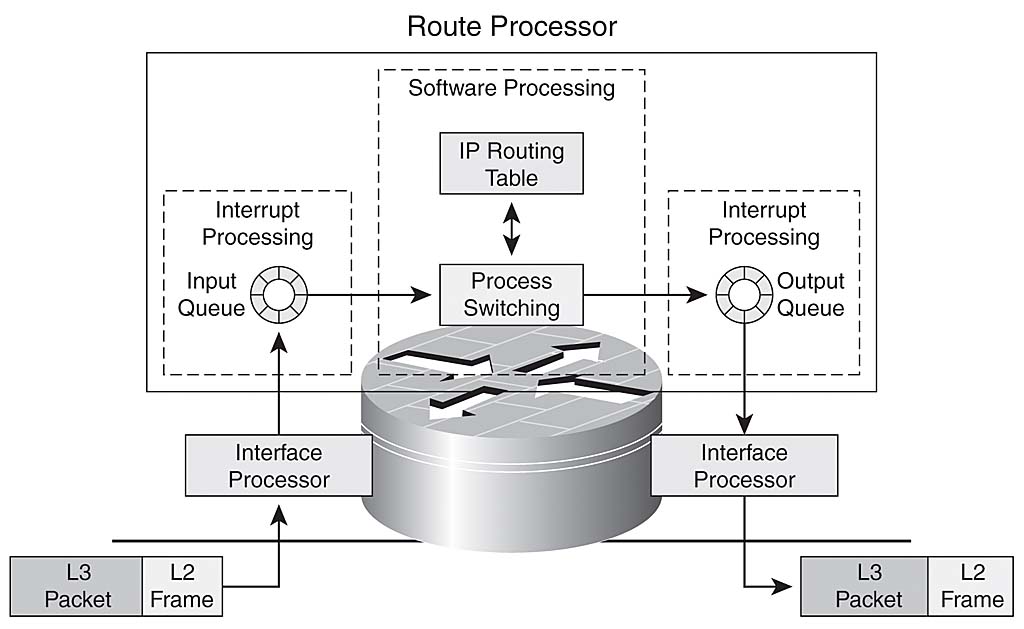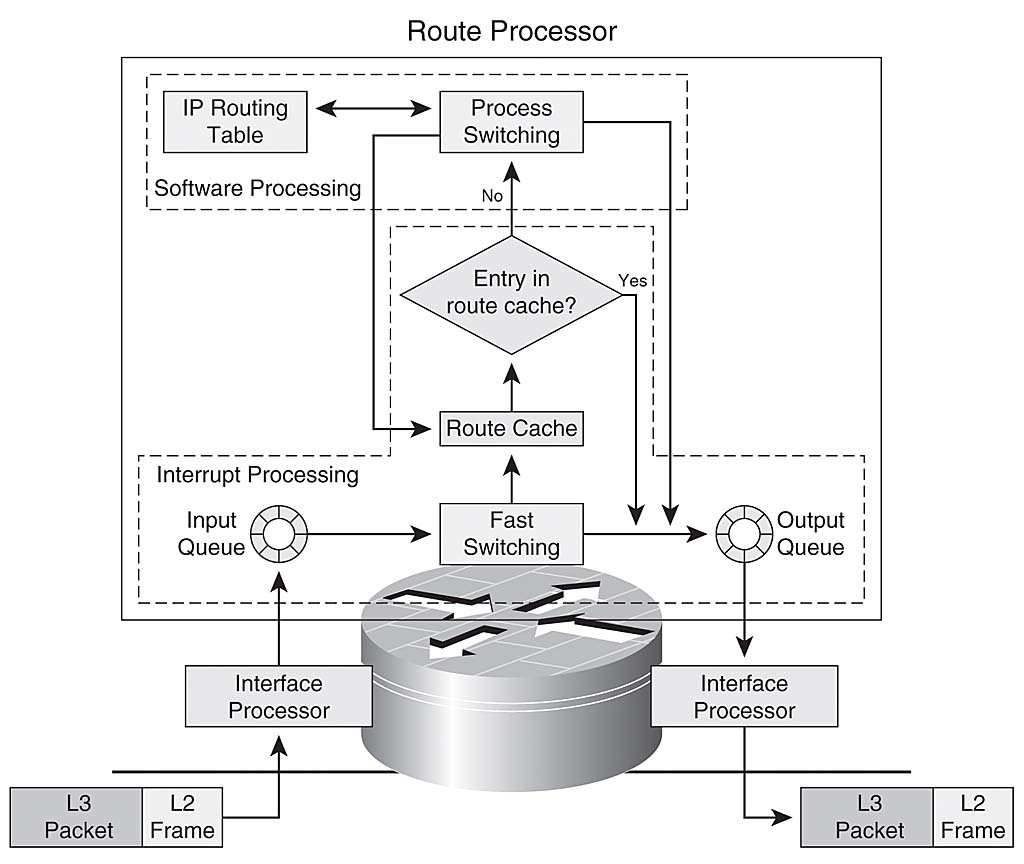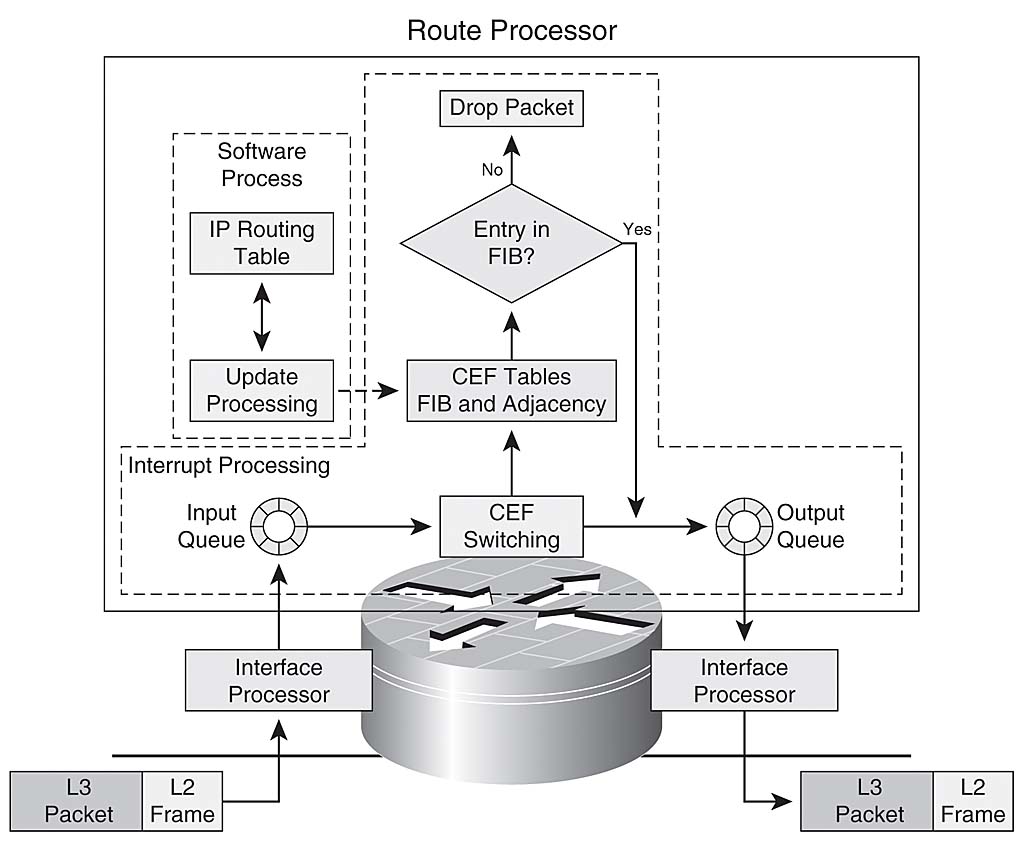Router functions or divided in 3 operations planes :
Management plane
“Management operation ( ssh , vty etc … )”
Control Plane”
“Packet Fowarding Decision ( routing protocols )”
Data Plane
“Forwading Decision through a router ( End user to Web server on a different Network )”
Do not get confuse with the word switching being a layer 2 level , frame switching is layer 2 and packet switching is layer 3
What is CEF?
Definition from Cisco.com :
Cisco Express Forwarding (CEF) is advanced, Layer 3 IP switching technology. CEF optimizes network performance and scalability for networks with large and dynamic traffic patterns, such as the Internet, on networks characterized by intensive Web-based applications, or interactive sessions.
To understand this better, one has to understand why and how CEF came about. With Cisco IOS there are different Switching Methods, that define how packets are forwarded through a router. The first method, which happens to be the oldest and slowest is Process-Switching. Alternatively when packets arrive, the interface processor can interrupt the central CPU and asks it to switch the packet according to a route cache or switching table. That cache or table can be built in several ways, the two of interest here are Fast-Switching and CEF.
With Process-Switching, when a packet enters the router the Layer-2 info is stripped off, the packet is then copied to the CPU memory where a L3 lookup is performed, and any other CPU required features, like NAT, queuing, compression etc, along with any other housekeeping like lowering the TTL, recalculating the CRC are done, before the frame is rewritten with the new L2 destination address and sent to the outgoing interface. The Big, the Bad and the Ugly!
With Fast-Switching, the first packet in a flow is still copied to the CPU for the L3 lookup and housekeeping, before being rewritten with the L2 destination address. The switching of the first packet by the central CPU gives the CPU the opportunity to build a cache called the fast-switching cache, which is used to switch all subsequent packets for the same destination using the same switching path across the router. With Fast-Switching the cache is only built on demand, which can be time consuming when huge numbers of potential destinations are involved. To avoid this a pre-build cache was needed, and thus CEF was born.
With CEF (Cisco Express Forwarding), there are two main data structures:
- The Adjacency-Table : is responsible for the MAC or Layer 2 rewrite. This adjacency can be built from ATM, Frame Relay map statements, dynamic information learned from Ethernet-ARP, inverse ARP on ATM, or Frame Relay. The Layer 2 rewrite string contains the new Layer 2 header which is used on the forwarded frame. For Ethernet, this is the new destination and source MAC address and the Ethertype. For PPP, the Layer 2 header is the complete PPP header, including the Layer 3 protocol ID.
- FIB (Forwarding Information Base) Table : The CEF table/FIB table holds the essential information, taken from the routing table, to be able to make a forwarding decision for a received IP packet. This information includes the IP prefix, the recursively evaluated next hop, and the outgoing interface.
PROCESS SWITCHING:
How The router Process the packet :
The router remove the header from the incoming packet
The router examine the layer 3 addressing and take a decision how to forward the packet .
The layer 2 is then rewritten , which could mean changing the source and destination mac address computing cycle redundancy check ( CRC )
Then the packet is forwarded to the right interface.
Process Switching involve direct CPU process … in another word : router configured for process switching can suffer significantly.
To configure an interface for Process Switching you need to disable Fast Switching on that interface
no ip route-cache
Fast Switching use the router cache maintain by the router data plane.
How The router Process the packet :
The 1st packet in a data flow is process by the cpu
The router determine how to forward the 1st frame of data flow from the router fast cache information .
Fast Switching can reduce a router Cpu utiliziation compare to Process Switching.
To configure Fast Switching is can be configure on the interface by using :
ip route-cache
CISCO EXPRESS FORWARDING ( CEF )
The CEF process flow:
- When a packet enters the router, the router strips off the Layer 2 information.
- The router looks up the destination IP address in the CEF table (FIB), and it makes a forwarding decision.
- The result of this forwarding decision points to one adjacency entry in the adjacency table.
- The information retrieved from the adjacency table is the Layer 2 rewrite string, which enables the router to put a new Layer 2 header onto the frame,
- The packet is switched out onto the outgoing interface toward the next hop.
CEF is enable by default on most routers if not we can enable it by default using the command : ip cef you can enable it on a interface base by using the command : ip route-cache cef








